
Story of the Week... Editorial of the Week... Toon of the Week... Quote of the Week... Graphic of the Week... Photo of the Week... SkS Spotlights... Video of the Week... Coming Soon on SkS... Poster of the Week... Climate Feedback Reviews... SkS Week in Review... 97 Hours of Consensus...
As snow falls in Rome, the Arctic is getting alarmingly hot in the middle of winter.

It’s been downright toasty at the North Pole, at least by Arctic standards.
The northernmost weather station in the world, Cape Morris Jesup in Greenland, saw temperatures stay above freezing for almost 24 hours straight last week, and then climb to 43 degrees Fahrenheit (6.1 degrees Celsius) on Saturday (Feb 24) before dropping again.
But that Saturday (Feb 24) temperature was a whopping 45 degrees Fahrenheit above what’s normal this time of year:
The North Pole just had an extreme heat wave for the 3rd winter in a row by Umair Urfan, Energy & Environment, Vox, Feb 28, 2018
An earthly paradise is ravaged by inferno and flood, the earth itself rising to proclaim a horrifying and deadly new normal

When people ask me where I live and I say, “Santa Barbara,” I wait for the inevitable reply, “Paradise,” and the quizzical look that says, how does one live there, rather than vacation. It’s as if I had replied, Disneyland.
People who visit from colder climates have been complaining lately. Last year, when it finally rained after six years of drought, and we were practically on our knees with gratitude, a woman from New England remarked, “I didn’t come here for the rain.” I almost said, “Well, then, why don’t you go back home?” Another pestered a friend: when was her club in Montecito going to open? My friend replied, “I think it’s under eight feet of mud.” She wanted to add, “And they’re still looking for the bodies.”
It’s always been a struggle here to have a normal life, to hold on to reality.
Southern Californians know: climate change is real, it is deadly and it is here, Opinion by Nora Gallagher, Environment, Guardian, Mar 3, 2018
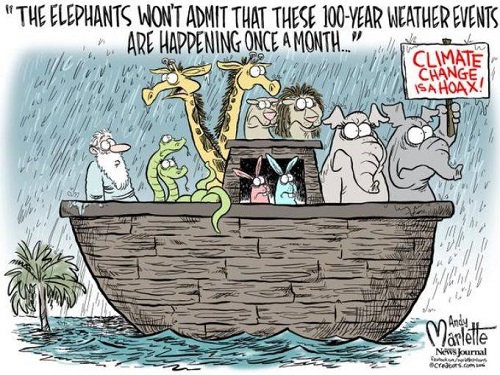
A study published in 2017 found that these types of warming events have been increasing in frequency and duration during winter as the Arctic continues to warm at more than twice the rate of the rest of the globe.
"What’s exactly driving these changes is not clear, but having storm tracks move further north (i.e. the North Atlantic storm track) may be tied to the northward retreat of the ice edge," said Julienne Stroeve, a senior research scientist at the National Snow and Ice Data Center in Boulder, Colorado, in an email.
"Thus, while having temperatures exceed freezing during winter is not uncommon, but it may be becoming more common as the climate changes and the ice edge continues to retreat."
Stroeve said that it's not just summer and fall sea ice showing steep declines, but that this is occurring year round now. "What it shows us too is that the winter sea ice is now also starting to respond as every winter now for the past 4 winters has been more extreme than the year before in terms of record low sea ice," she said.
Drastic Arctic warm event stuns scientists, as record-breaking temperatures reach the North Pole by Andrew Freedman, Mashable, Feb 26, 2018
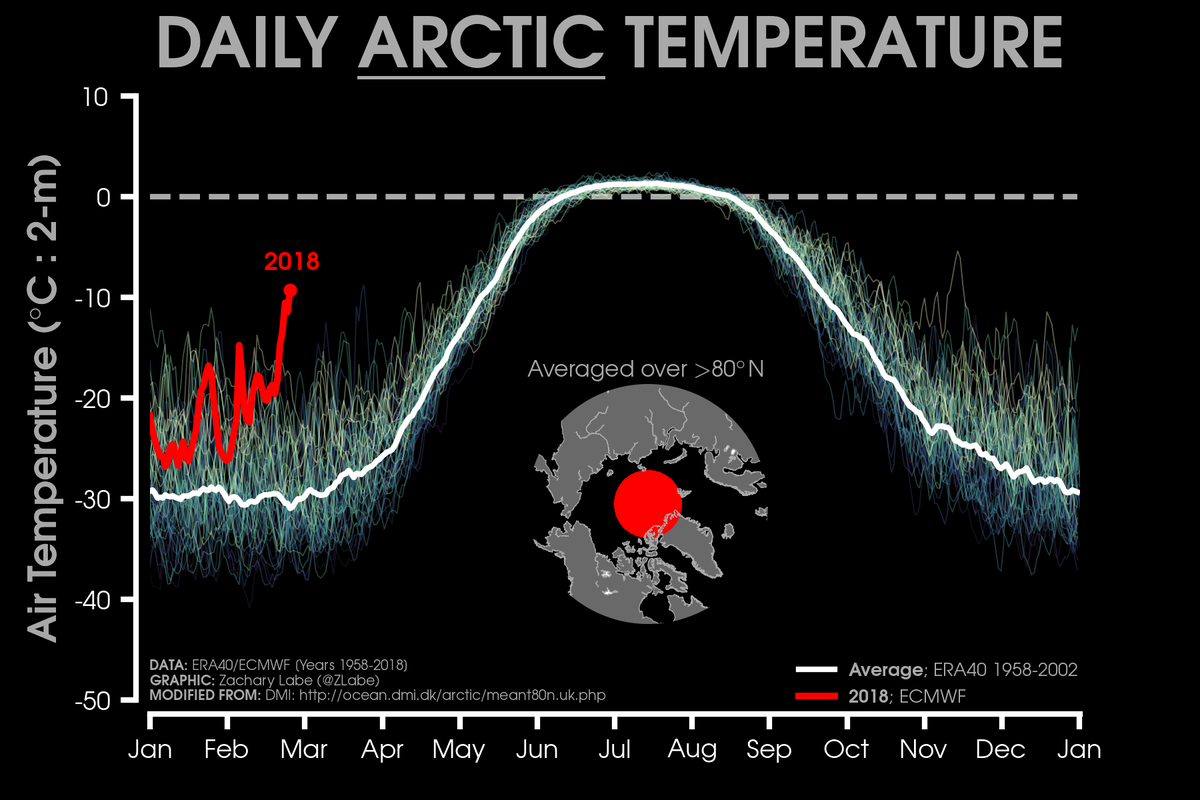
Daily 2 meter surface air temperature for the Arctic averaged above 80°N. Individual years from 1958-2017 are shown by the sequential blue/purple to yellow lines. 2018 is indicated by the red line. The white line shows the average temperature.
Zack Labe, a climate scientist at the University of California at Irvine, has a knack for creating compelling visuals of Arctic sea ice trends and air temperatures. His data corroborate this narrative, and this analogy, showing a sharp and persistent spike in air temperatures during February to the north of 80 degrees North Latitude.
"The duration of this warmth is remarkable and a common feature of the last several winters," Labe said in a Twitter message. He said that while warm air intrusions occur every winter, this one is unusual for occurring during February, lasting longer than a week, and for "the extent/magnitude of the moisture transport into the Arctic."
"I think the takeaway is that the dramatic wintertime warming of the Arctic continues in addition to a long-term trend in decreasing sea ice. These effects, along with others, have significant physical, environmental, social, and political consequences for the Arctic and beyond," he said.
Drastic Arctic warm event stuns scientists, as record-breaking temperatures reach the North Pole by Andrew Freedman, Mashable, Feb 26, 2018
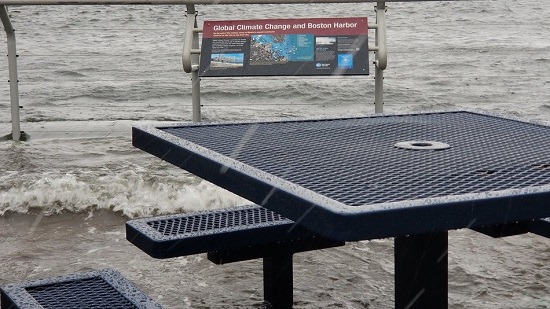
Boston Harbor flooding during a major nor'easter on March 2, 2018. (Look at the sign.)
This one picture sums up climate change's growing role in coastal flooding by Andrew Freedman, Mashable, Mar 3, 2018
The CitiesIPCC Cities and Climate Change Science Conference aims to assess the state of academic and practice-based knowledge related to cities and climate change, and to establish a global research agenda based on the joint identification of key gaps by the academic, practitioner and urban policy-making communities. The conference is organized by CitiesIPCC and will be held in Edmonton from March 5-7, 2018.

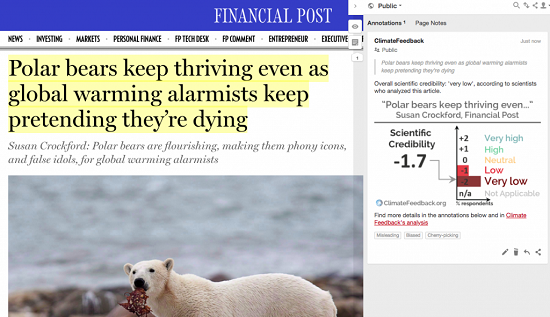
Climate Feedback asked its network of scientists to review the opinion piece, Polar bears keep thriving even as global warming alarmists keep pretending they’re dying by Susan Crockford, Financial Post, Feb 27, 2018
Three scientists analyzed the article and estimate its overall scientific credibility to be 'very low'.
A majority of reviewers tagged the article as: Biased, Cherry-picking, Misleading.
Review Summary
This article in the opinion section of Financial Post, written by Susan Crockford, claims that rather than being threatened by declining Arctic sea ice, polar bears are “thriving”.
Three scientists who reviewed the article explained that this article fundamentally misrepresents research on the topic. The author exhibits poor reasoning in arguing that polar bear population loss projected for 2050 should have occurred already if that science was accurate. Researchers do not ignore the evidence Crockford claims they do, but instead incorporate all published research on polar bear populations. Despite the article’s statements to the contrary, research shows that polar bear populations will struggle as ice-free periods (during which they cannot hunt for food) grow longer.
Financial Post publishes misleading opinion that misrepresents science of polar bears’ plight, Climate Feedback, Mar 2, 2018
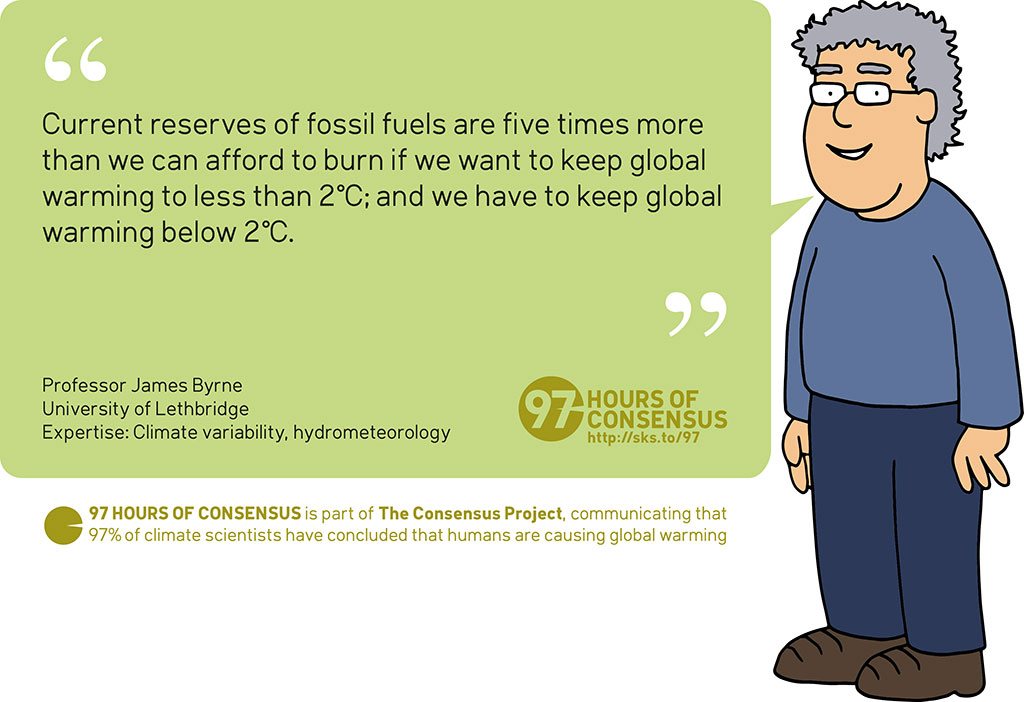
James Byrne's bio page and quote source.
High resolution JPEG (1024 pixels wide)
Posted by John Hartz on Sunday, 4 March, 2018
 |
The Skeptical Science website by Skeptical Science is licensed under a Creative Commons Attribution 3.0 Unported License. |